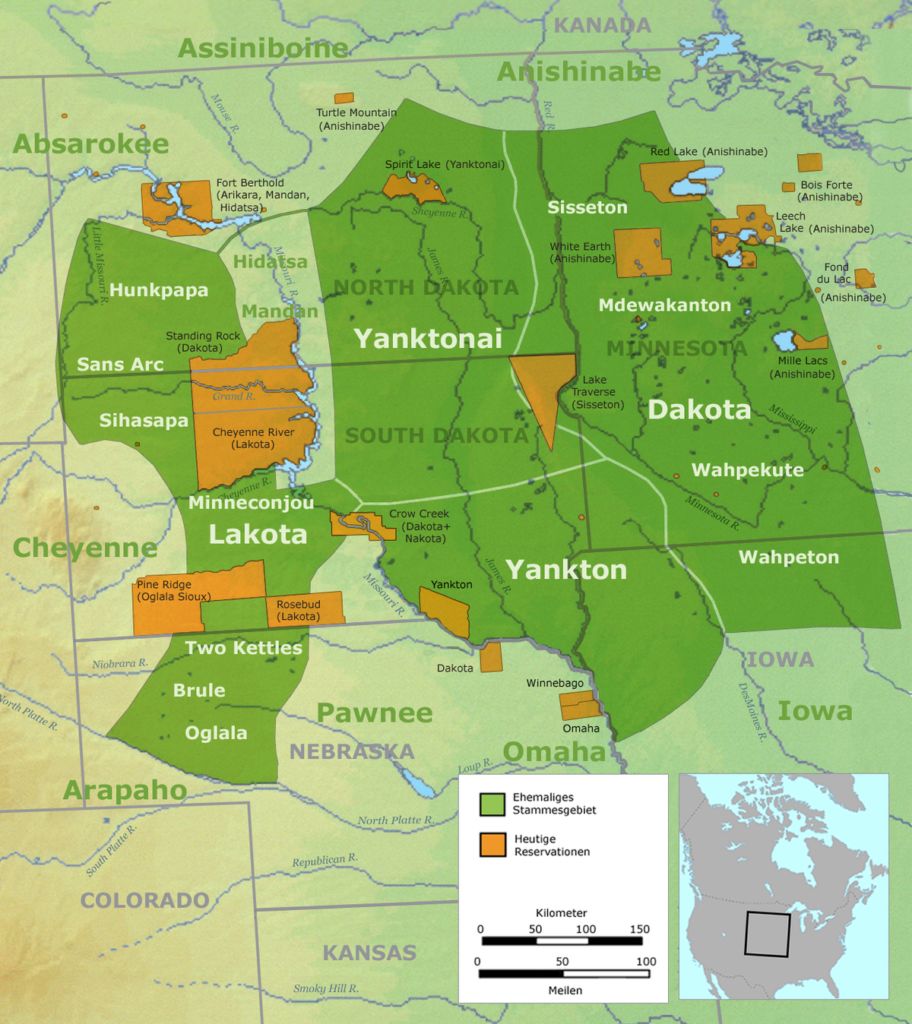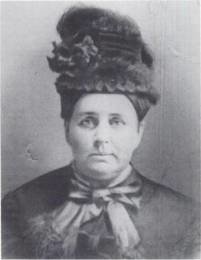
In August of 1862, Sarah Wakefield and her two children were captured by a group of Dakotas, members of the Indigenous Sioux nation residing along the Minnesota river, as part of the Sioux’ resistance against the United States’ ongoing dispossession of their land and violence against their people. For several years prior to her captivity, Wakefield had been accompanying her husband John in Minnesota, where he worked as a physician for the Sioux. Wakefield’s “Six Weeks in the Sioux Tepees: A Narrative of Indian Captivity” shows not only the unique way in which she perceived the Indigenous people she lived among, but also what those depictions reveal about her own identity as a white Christian woman of the 19th century.
THE CAPTIVITY TALE

vs. Sioux reservation today (orange)
Typically, captivity narratives were used to defame Native Americans, largely portraying them as “savages” who pose a threat to the expanding Western civilization and especially to the White Woman representing purity and fertility. This caricature of Indigenous people served as a means to justify their elimination to the public, ridding them of any empathy towards people who allegedly rape their women and endanger their future (Kolodny 192). The Sioux tribes, for instance, had been expelled from their land and starved out by white settlers long before the “war” of 1862, all under the guise of protecting proper Christian values, the necessity of which was propagated in various captivity tales.
HYPOTHESIS
During her time spent as a captive of the Sioux, Sarah Wakefield learned to develop an understanding and empathy for a select few of them, which ultimately led her to question her world view and advocate for them. However, her narrative still reveals truths about her identity that are built upon Christianity and white supremacy.
Sarah Wakefield’s perspective differs somewhat from the established perception of Native Americans as usually depicted in captivity tales. Unlike the majority of white Americans in the 19th century, she engages with some of the Sioux on a level that is equal to her interactions with other white people, stating that they were “very kind, good people” (Wakefield 61). After being protected and aided by quite a few of the Natives during the six weeks of her captivity, she expresses her gratitude, pointing out that she believed to be “indebted to those friendly Indians for [her] life and honor” (81). Especially Chaska, one member of the Dakota tribe who had first saved her from death and then proceeded to support her, is mentioned a number of times, emphasizing Wakefield’s gratitude and the special bond she had with him. Her reaction to him being imprisoned after the white settlers defeated the Sioux shows her deep appreciation for him and his kind acts: “I know that I did what was right, that my feelings were only those of gratitude toward my preserver,” (123) she offers as an explanation for the lengths she went to defend him in court. Moreover, she finds herself realizing that some of the Natives do show good, Christian morals, unlike some of the white people she would have associated herself with without question before—namely those who wrongfully executed Chaska despite assuring Wakefield he would be spared after the Sioux‘ imprisonment. This leads to her questioning the authorities and further alienates her from her own people. She clearly distances herself from the government, and ultimately her own American identity is questioned: “It has caused me to feel very unkindly towards my own people” (123). Thus, it is evident that Wakefield ends up prioritizing Christian morals, making them a major part of her identity construction.

Yet all of this is not to say that Wakefield did not adhere to prejudiced beliefs about Native Americans and notions of her own people’s superiority. On the contrary—it is clear that her support for the Sioux is deeply conditional. In the beginning of her stay with them, she refers to them by various derogatory terms that do not need to be repeated, expecting them all to be violent towards her and other white people, and being surprised when many of them are kind to her. She believes the several acts of kindness that the Sioux show her to stem from an unexpected subscription to Christianity on their part, and it is only then that Wakefield learns to respect them “as if they were whites” (61). At one point she states, “Many persons say the Indian cannot be civilized. I think they can, but did not know it until I lived among them.” (57), which shows her belief that there is a need for Indigenous people to be ‘civilized’ in the first place, that their Westernization is a right and just cause. She pushes the dichotomy of ‘civilized’ versus “wild man” (64), ultimately proving that her upbringing as a rich, white Christian woman instilled some sense of superiority over others into her. What is remarkable about Wakefield, however, is that she does not use her immense privilege over the Sioux against them, instead making great efforts to save Chaska from execution despite that putting her own reputation at risk. She explains, “I never could love a savage, although I could respect any or all that might befriend me, and I would willingly do everything in my power to benefit those that were so kind to me in my hour of need.” (117) Coming from a woman in her position, these actions can in no way be taken for granted and show that perhaps her journey has altered some aspects of her identity.
In conclusion, Wakefield’s accounts of the Sioux as well as her own identity constructions appear to be profoundly contradictory. While she cherishes the graciousness and humanity of those that treat her kindly, at the same time she looks down upon others who do not appear ‘civilized’ and Christian enough to her. It is these same Christian standards, however, that she holds her government to as well, causing her to distance herself from her own people’s lack of morality, which is a decidedly rare voice for the time.
Sources:
Akers, Donna L. “Indigenous Nations and the United States.” The Cambridge History of America and the World: Volume 2: 1812–1900, edited by Jay Sexton and Kristin Hoganson, vol. 2, Cambridge University Press, 2022, pp. 60–79. https://doi.org/10.1017/9781108297479.004.
→ explains settler colonialism, dispossession and subjugation of Native peoples
Ciani, Kyle E. Ethnohistory, vol. 46, no. 1, 1999, pp. 192–95. JSTOR, http://www.jstor.org/stable/483442. Accessed 28 May 2022
→ analysis of how Wakefield defies the idea of “true womanhood” and typical captivity narratives by portraying some of her captors in a positive light and holding her government accountable
Fiorentino, Daniele. The Journal of American History, vol. 86, no. 4, 2000, pp. 1787– 89. JSTOR, https://doi.org/10.2307/2567640. Accessed 28 May 2022.
Kolodny, Annette. “Among the Indians: The Uses of Captivity.” Women’s Studies Quarterly, vol. 21, no. 3/4, 1993, pp. 184–95. JSTOR, http://www.jstor.org/stable/40022022. Accessed 28 May 2022.
→ information on captivity tales and how they propagated negative notions of Indigenous peoples
Wakefield, Sarah F., and June Namias. Six Weeks in the Sioux Tepees: A Narrative of Indian Captivity. University of Oklahoma Press, 1997.
→ Editor’s introduction provides insights into the Dakota War of 1862 and Sarah Wakefield’s life
Pictures:
Cover image: https://i.gr-assets.com/images/S/compressed.photo.goodreads.com/books/1449655197l/28151679.SY475.jpg
Sarah F. Wakefield: https://www.womenhistoryblog.com/wp-content/uploads/2013/01/sarahwakefield.jpg
Sioux territory: https://de.wikipedia.org/wiki/Sioux#/media/Datei:Sioux01.png